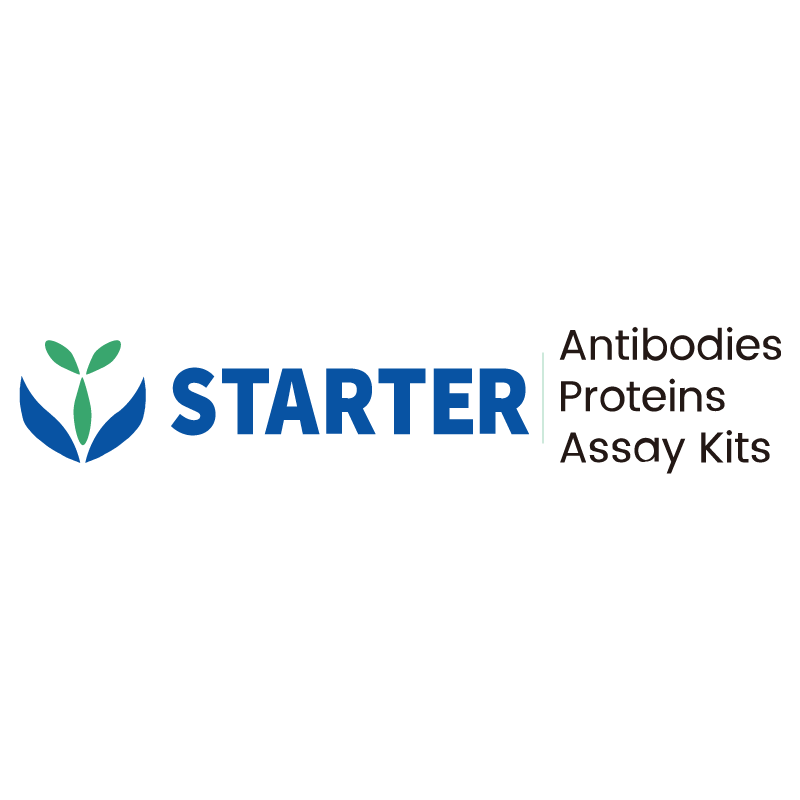WB result of Lactate Dehydrogenase Rabbit pAb
Primary antibody: Lactate Dehydrogenase Rabbit pAb at 1/1000 dilution
Lane 1: KATO Ⅲ whole cell lysate 20 µg
Lane 2: HeLa whole cell lysate 20 µg
Lane 3: HCC827 whole cell lysate 20 µg
Secondary antibody: Goat Anti-rabbit IgG, (H+L), HRP conjugated at 1/10000 dilution
Predicted MW: 37 kDa
Observed MW: 35 kDa
Product Details
Product Details
Product Specification
| Host | Rabbit |
| Antigen | Lactate Dehydrogenase |
| Synonyms | L-lactate dehydrogenase A chain; LDH-A; Cell proliferation-inducing gene 19 protein; LDH muscle subunit (LDH-M); Renal carcinoma antigen NY-REN-59; LDHA; PIG19; L-lactate dehydrogenase B chain; LDH-B; LDH heart subunit (LDH-H); Renal carcinoma antigen NY-REN-46; LDHB |
| Immunogen | Synthetic Peptide |
| Location | Cytoplasm |
| Accession | P00338、 P07195 |
| Antibody Type | Polyclonal antibody |
| Isotype | IgG |
| Application | WB, IHC-P, ICC |
| Reactivity | Hu, Ms, Rt |
| Positive Sample | KATO III, HeLa, HCC827, NIH/3T3, mouse heart, mouse skeletal muscle, C6, rat heart, rat skeletal muscle |
| Predicted Reactivity | Cz,Bv |
| Purification | Immunogen Affinity |
| Concentration | 0.5 mg/ml |
| Conjugation | Unconjugated |
| Physical Appearance | Liquid |
| Storage Buffer | PBS, 40% Glycerol, 0.05% BSA, 0.03% Proclin 300 |
| Stability & Storage | 12 months from date of receipt / reconstitution, -20 °C as supplied |
Dilution
| application | dilution | species |
| WB | 1:1000 | Hu, Ms, Rt |
| IHC-P | 1:200 | Ms, Rt |
| ICC | 1:500 | Hu |
Background
Lactate dehydrogenase (LDH) is an enzyme that catalyzes the interconversion of pyruvate and lactate, playing a crucial role in anaerobic glycolysis and energy metabolism. It exists as five isoenzymes (LDH-1 to LDH-5), which are tetramers composed of different combinations of M and H subunits. LDH is widely expressed in various tissues, with different isoenzymes having distinct tissue distributions and functions. For instance, LDH-1 is abundant in the heart, while LDH-5 is prevalent in skeletal muscle and liver. In addition to its metabolic role, LDH is a biomarker for tissue damage, as its release into the bloodstream indicates cell injury or necrosis. Elevated LDH levels are commonly observed in conditions such as myocardial infarction, liver disease, and hemolysis. In cancer, LDH is involved in the Warburg effect, promoting tumor growth and survival by facilitating lactate production under hypoxic conditions. LDH also contributes to the acidic tumor microenvironment, which supports immune evasion and metastasis.
Picture
Picture
Western Blot
WB result of Lactate Dehydrogenase Rabbit pAb
Primary antibody: Lactate Dehydrogenase Rabbit pAb at 1/1000 dilution
Lane 1: NIH/3T3 whole cell lysate 20 µg
Lane 2: mouse heart lysate 20 µg
Lane 3: mouse skeletal muscle lysate 20 µg
Secondary antibody: Goat Anti-rabbit IgG, (H+L), HRP conjugated at 1/10000 dilution
Predicted MW: 37 kDa
Observed MW: 35 kDa
WB result of Lactate Dehydrogenase Rabbit pAb
Primary antibody: Lactate Dehydrogenase Rabbit pAb at 1/1000 dilution
Lane 1: C6 whole cell lysate 20 µg
Lane 2: rat heart lysate 20 µg
Lane 3: rat skeletal muscle lysate 20 µg
Secondary antibody: Goat Anti-rabbit IgG, (H+L), HRP conjugated at 1/10000 dilution
Predicted MW: 37 kDa
Observed MW: 35 kDa
Immunohistochemistry
IHC shows positive staining in paraffin-embedded mouse cardiac muscle. Anti-Lactate Dehydrogenase antibody was used at 1/200 dilution, followed by a HRP Polymer for Mouse & Rabbit IgG (ready to use). Counterstained with hematoxylin. Heat mediated antigen retrieval with Tris/EDTA buffer pH9.0 was performed before commencing with IHC staining protocol.
IHC shows positive staining in paraffin-embedded mouse skeletal muscle. Anti-Lactate Dehydrogenase antibody was used at 1/200 dilution, followed by a HRP Polymer for Mouse & Rabbit IgG (ready to use). Counterstained with hematoxylin. Heat mediated antigen retrieval with Tris/EDTA buffer pH9.0 was performed before commencing with IHC staining protocol.
IHC shows positive staining in paraffin-embedded rat cardiac muscle. Anti-Lactate Dehydrogenase antibody was used at 1/200 dilution, followed by a HRP Polymer for Mouse & Rabbit IgG (ready to use). Counterstained with hematoxylin. Heat mediated antigen retrieval with Tris/EDTA buffer pH9.0 was performed before commencing with IHC staining protocol.
IHC shows positive staining in paraffin-embedded rat skeletal muscle. Anti-Lactate Dehydrogenase antibody was used at 1/200 dilution, followed by a HRP Polymer for Mouse & Rabbit IgG (ready to use). Counterstained with hematoxylin. Heat mediated antigen retrieval with Tris/EDTA buffer pH9.0 was performed before commencing with IHC staining protocol.
Immunocytochemistry
ICC shows positive staining in HeLa cells. Anti- Lactate Dehydrogenase antibody was used at 1/500 dilution (Green) and incubated overnight at 4°C. Goat polyclonal Antibody to Rabbit IgG - H&L (Alexa Fluor® 488) was used as secondary antibody at 1/1000 dilution. The cells were fixed with 100% ice-cold methanol and permeabilized with 0.1% PBS-Triton X-100. Nuclei were counterstained with DAPI (Blue). Counterstain with tubulin (Red).


